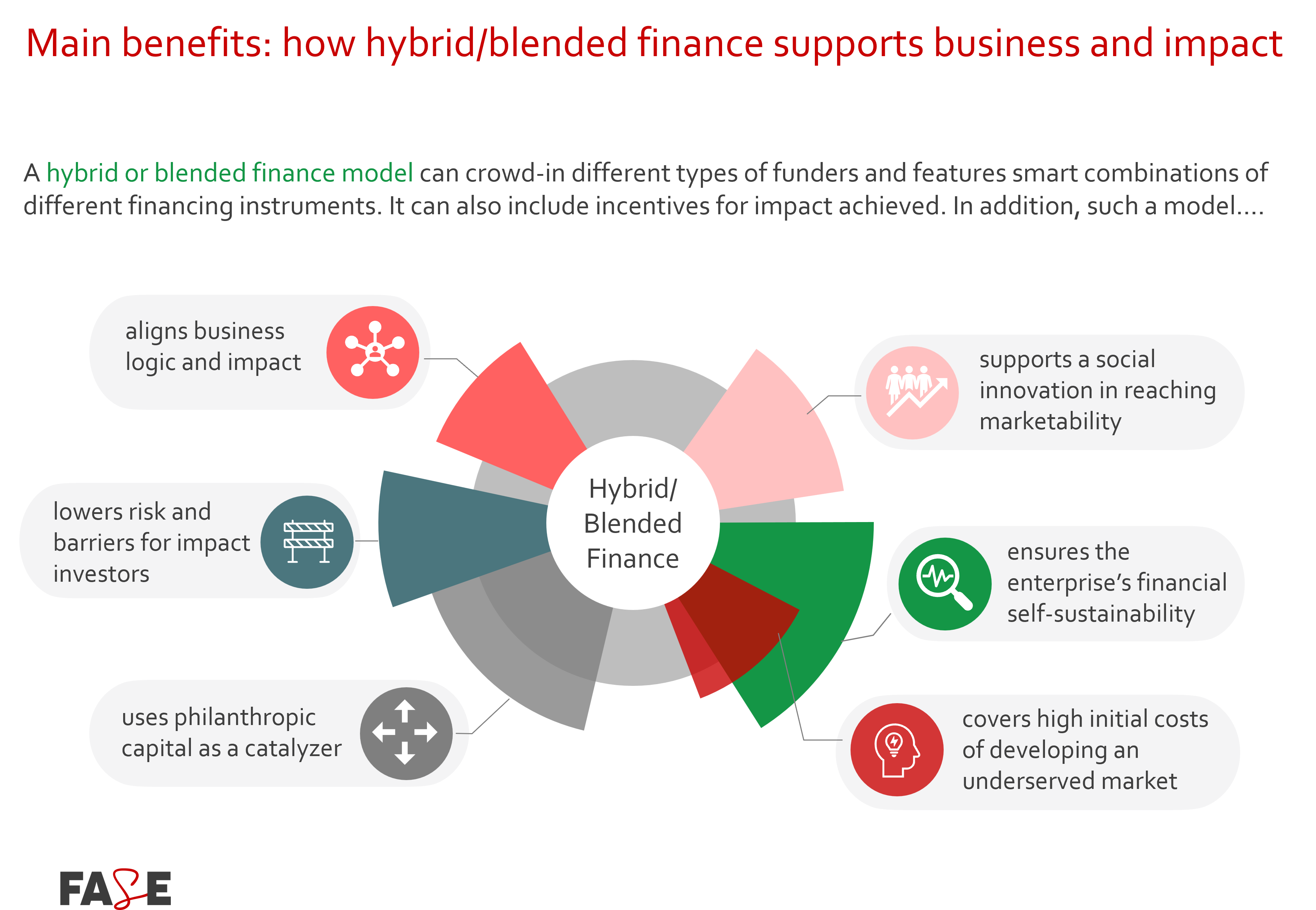Impact entrepreneurs: the masterminds behind blended finance
High-impact enterprises can struggle for the funding they need to scale up. Blended finance has a growing track record of being the right tool for the job, finds Christina Moehrle, in the first of a two-part deep dive into ‘the new impact finance kid on the block’. (Find part 2 here.)
Blended finance has often been hailed as the new impact finance kid on the block. And rightfully so: since it officially appeared on the scene with OECD’s and WEF’s primer in 2015, it has become a power screwdriver in any development finance toolbox from KfW’s to SDC’s to IDB Invest’s and many others across the globe.
However, to unleash the superpowers of new tools for impact, practitioners need to know that blended finance is not a Swiss army knife for every development challenge. “It can be tempting to fall in love with these new tools, but it is important to recognise that they do not fit all situations or problems,” said UBS Optimus Foundation’s Nalini Tarakeshwar and Sheryl Fofaria in their recent opinion piece.
If done well, blended finance uses public and philanthropic funding to catalyse much-needed capital from the private sector – aka (impact) investors – towards sustainable development. Targets are not only huge projects in developing countries that address one or several SDGs, but also smaller impact ventures that provide solutions to specific social and/or ecological problems. The trick behind blended finance: plugging in catalytic capital can decrease the risks – or increase the returns – of a given transaction and thus attract more commercially-minded investors.
- Read more in our Impact 101: What is blended finance?
Such a structuring approach can come in many shapes and sizes: from layered blended funds to design-stage grants to guarantees to technical assistance funds to impact-linked finance approaches. There is no lack of powerful screwdriver designs to choose from. In practice, though, it can be challenging to align different animals from planet finance with their different risk-return-impact appetites. Yet an important goal justifies the extra complexity: to bridge the staggering SDG financing gap of US$3.9tn per annum. So far, around US$202bn has been mobilised through blended finance, as estimated by the global network Convergence.
Impact entrepreneurs: the real first-movers
What is often forgotten, however, is that impact entrepreneurs have been using the same approach for decades. Not always by design but often out of scarcity, they have been mixing different financial instruments from different capital providers to make ends meet, albeit on a much smaller scale.
Impact entrepreneurs have been using the same approach for decades…they have been mixing different financial instruments from different capital providers to make ends meet
A 2022 research report by the Initiative for Blended Finance, sponsored by the Catalytic Capital Consortium, came to the same finding: “What seems to be completely missing from the typical statistics on blended finance is that many entrepreneurs use grants to raise additional capital. They are creating their own bottom-up blended finance solutions, so to speak, by blending grants and concessionary capital with investments from a range of impact investors, development finance institutions and foundations.”
Sometimes, this mix spans the enterprise’s entire lifecycle. For example, a grant from a foundation finances the very early and risky stages while different types of investors with repayable instruments join when things have become a bit more stable. The same mix can also be used within one single financing round. Then, the blending approach is also called “hybrid finance” and brings unique characteristics to the mix. For example, impactful extra ingredients such as outcomes-based mechanisms can financially reward the enterprise for achieving pre-defined impact goals. This can give them “increased flexibility and autonomy”, as Impact Europe highlights in its 2017 hybrid finance report.
Therefore, if we asked, “Who invented blended finance?”, impact entrepreneurs would have every right to raise their hands.
The secret sauce in the blender
Yet inventorship aside, “public and commercial funding can go very well together”, confirms Joost van Engen, founder of Healthy Entrepreneurs, from first-hand experience. Both Healthy Entrepreneurs and Ignitia are part of a success study series created by FASE that aims to highlight how impact ventures have successfully used blended/hybrid finance to scale. One key ingredient in the blender is catalytic capital. As a rather rare type of investment capital that is patient, risk-tolerant, concessionary, and flexible, it is usually provided by impact-first or impact-only investors such as development agencies, foundations, family offices, or development finance institutions (DFIs).

In the case of Healthy Entrepreneurs, this catalytic capital came in the form of a grant from the Nationale Postcode Loterij. To help the enterprise pursue its vision of access to basic healthcare in rural Sub-Saharan Africa, hybrid finance proved to be the best approach in two financing rounds to date. “Blending public and commercial funding provides a good fit for impactful business cases in the health sector, but it’s also well-suited for other fields in the sustainability space,” van Engen points out.
To date, hybrid or blended finance has empowered many impact entrepreneurs and created multiple benefits for them
If dosed correctly – not too much, not too little – catalytic capital is indeed a powerful ingredient: For Ignitia, a recoverable grant from the DEG Upscaling programme spiced up the blend of financing providers and instruments in a US$4.2m round in 2021. Mezzanine capital from the European Social Innovation and Impact Fund (ESIIF) mixed with equity investments from Novastar Ventures, Ikea Social Entrepreneurship and several others helped the Sweden-based climate intelligence and forecasting pioneer for agribusinesses to reach 2.6m farmer subscriptions by March 2023. It also boosted Ignitia’s impact: 79% of the enterprise’s active users said that they value the usefulness of its data, advice on farming, and facilitation of easier decision-making to achieve better yields and higher productivity for their farms.
Healthy benefits for impact entrepreneurs
Ignitia and Healthy Entrepreneurs are just two impact ventures using this blending approach. To date, hybrid or blended finance has empowered many impact entrepreneurs and created multiple benefits for them. FASE, which has been advising its impact enterprise clients on these approaches since 2013, has fleshed out the most important benefits.

- Impact enterprises can cover the high initial costs of developing an underserved market. When pioneering new markets or business models, the financing gap is often especially huge. Catalytic capital can fund this volatile stage and prepare the ground for other investors to join.
- Impact enterprises can better align business logic and impact. Rather than being torn between impact and profit growth, impact enterprises benefit from a better-aligned investor consortium. This leads to less tension and a lower risk of mission drift.
- Impact enterprises can reach marketability for their innovative solutions. A hybrid finance model can successfully fund the enterprise until it reaches proof of concept and is ready to launch its products and services to the market.
- Impact enterprises can lower the barrier for other investors. Catalytic capital from public or philanthropic funders can decrease the risk or enhance the returns of an entire financing round. This can crowd in investors who look for a better risk-return profile and would otherwise shun the transaction.
- Impact enterprises can ensure their longer-term financial self-sustainability and boost their impact. If outcomes-based mechanisms are part of a hybrid finance deal, entrepreneurs can be incentivised with financial rewards for the achievement of more ambitious impact targets. This can boost their impact and create an additional revenue stream that supports the enterprise in reaching financial break-even and sustainability.
In an imperfect financial market that doesn’t cater to the specific needs of high-impact enterprises, there are many more benefits of applying innovative approaches such as hybrid and blended finance.
In part 2 of this series, we will highlight another one: a smart blending solution for a portfolio of impact enterprise financings. Stay tuned for a deep dive into layered/blended fund structures!
Christina Moehrle is a freelance communications advisor working with FASE among others; this feature was produced in partnership with FASE.
Thanks for reading our stories. As an entrepreneur or investor yourself, you'll know that producing quality work doesn't come free. We rely on our subscribers to sustain our journalism – so if you think it's worth having an independent, specialist media platform that covers social enterprise stories, please consider subscribing. You'll also be buying social: Pioneers Post is a social enterprise itself, reinvesting all our profits into helping you do good business, better.




